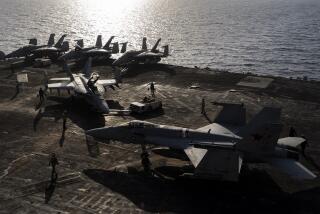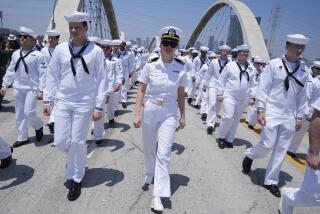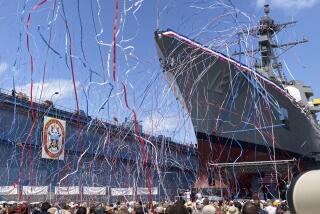A Second Farewell : History: Notables and current and former crew members honor World War II battleship Missouri as the Navy takes it out of service.
They said a reluctant goodby Tuesday to the battleship Missouri, a vessel her captain called âthe ship that every sailor in the world envies.â
There were public officials--politicians like U.S. Rep. Ike Skelton of Missouri, on hand in 1986 when the venerable, 58,000-ton dreadnought was returned to service and who was the principal speaker at Tuesdayâs decommissioning ceremonies in Long Beach.
There were members of her current crew--like Capt. A.L. Kaiss, who commanded the worldâs last active-duty battleship, and Seaman George Tababa, who helped scrub her teakwood decks.
And there were sailors from her past--men like Bob Schwenk, Art Albert and Richard Wilson, who were on the ship when she survived a kamikaze attack off Okinawa, and a few months later, on Sept. 2, 1945, when Japanese officials signed the surrender documents on her deck that ended one of the bloodiest wars in history.
âItâs sad,â Schwenk said softly, blinking away the tears as a signalman ran down the shipâs ensign for the last time.
âThey wonât bring her back again,â the 65-year-old Long Beach resident said. âItâs the end of an era.â
The last battleship built by the United States, the Missouri was launched Jan. 29, 1944. Harry S. Truman, then the junior senator from the state for which the ship is named, was the main speaker that day, and his daughter, Margaret, smashed the champagne bottle against the bow that sent the ship sliding into New Yorkâs East River.
Five months later, equipped with nine 16-inch guns that could hurl 2,700-pound, armor-piercing shells more than 20 miles, the Missouri joined the three sister ships of her class--the Iowa, the New Jersey and the Wisconsin--in some of the closing battles of World War II.
The Missouri was participating in the shore bombardment of Okinawa in the spring of 1945 when Japanese aviators launched a suicide attack against the ship.
âI was a machinistâs mate, working damage control, when one of those kamikaze planes hit the ship,â Albert, now 65, said Tuesday. âSure I was scared. . . . When I opened the hatch, there was the wing, right in my face.â
Albert said he slammed the hatch shut and escaped the flames, but he said the battered knees he suffered tumbling down a ladder are giving him trouble these days.
After completing operations off Okinawa and Iwo Jima, the Missouri was preparing for the planned invasion of Japanâs home islands in the fall of 1945 when the atomic bombs dropped on Hiroshima and Nagasaki brought an end to the war.
Wilson, 73, said he was pulling his watch as a gunnerâs mate, stationed near the shipâs bridge, when Gen. Douglas MacArthur and Fleet Adm. Chester W. Nimitz joined Japanese officials on the deck for the official surrender ceremonies in Tokyo Bay.
âI was standing right above them when they signed the peace treaty,â Wilson said. âYou donât forget something like that.â
Except for a few diplomatic tours, the next five years were quiet for the Missouri, but in 1950, she found herself the only commissioned battleship ready for service in the Korean War. The enemy lacked warships for battle, so, once again, her role was shore bombardment.
Five years later, under leaden skies in Bremerton, Wash., the ship was decommissioned and placed âin mothballs.â There she remained for 31 years, serving only as a tourist attraction.
But in 1979 the United States was embarrassed by the takeover of its embassy in Tehran. Shortly thereafter, the country decided to flex a little military muscle and the Missouri was ordered back into service.
Later on, the refitted and still elegant Missouri went on an around-the-world cruise--the first American battleship to do so since President Theodore Roosevelt sent his Great White Fleet around the world in 1907.
In 1987, the ship was sent to the Persian Gulf to help safeguard shipping operations near the Strait of Hormuz. The Missouri returned to its home port of Long Beach, but last winter, it was back in the Persian Gulf, bombarding Iraqi positions with its Tomahawk missiles and its 16-inch guns during Operation Desert Storm.
But that was 1991, and this is 1992, the era of military cutbacks. Once again, the Missouri is headed for mothballs.
Schwenk, Albert and Wilson stood proudly at attention in the front row of several thousand guests Tuesday as a dockside band played âThe Star-Spangled Bannerâ to begin the battleshipâs second decommissioning ceremony.
To the 1,500 uniformed members of the current crew lining the bunting-bedecked rails of the ship, Capt. Kaiss addressed a final message.
âOur final day has arrived,â Kaiss said. âYou are a special breed of sailors and Marines and I am proud to have served with each and every one of you. . . .
âTo put away a ship that has become as much a part of you as you are to her is a sad ending to a great tour. But take solace in this--you have lived up to the history of the ship, and those who sailed her before us.â
More to Read
Sign up for Essential California
The most important California stories and recommendations in your inbox every morning.
You may occasionally receive promotional content from the Los Angeles Times.










